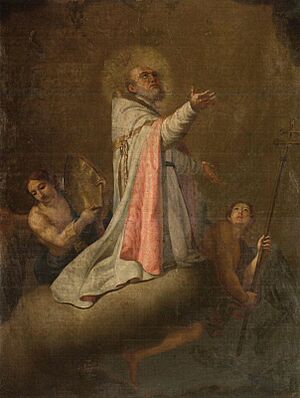Buenaventura Salesa facts for kids

Buenaventura Salesa (born in Borja, Spain, in 1755 – died in Zaragoza, Spain, on October 21, 1819) was a talented Spanish artist. He was known for his drawings and paintings in the Neo-Classical style. This art style was popular in the late 1700s and early 1800s, focusing on clear lines and calm scenes, inspired by ancient Greek and Roman art.
Early Life and Studies
Buenaventura Salesa began his art studies with Francisco Bayeu, a well-known painter. In 1770, he joined the Real Academia de Bellas Artes de San Fernando in Madrid. This was a famous art school where he lived with the sculptor Juan Pascual de Mena.
In 1772, Salesa won an award at the Academy for his drawings. He drew famous ancient statues like the Farnese Hercules and the Apollino. These drawings showed his skill and talent.
Four years later, King Carlos III gave him a special scholarship. This allowed Salesa to travel to Rome, Italy, to continue his art studies. He went there because Anton Raphael Mengs, a very important artist, recommended him.
Time in Rome
While in Rome, Salesa received help from José Nicolás de Azara, who was the Spanish Ambassador. Azara was a good friend of Mengs and was very impressed by Salesa's drawings. Many of Salesa's drawings were used in Azara's translation of a book called The Life of Cicero, published in 1790.
Salesa also worked on a big project to create engravings of paintings from royal palaces in Europe. He drew a painting by Mengs from the Palacio Real de Madrid, which showed the Descent from the Cross. This drawing was then turned into an engraving by another artist, Giovanni Volpato.
Later, Salesa made drawings for a series called Portraits of Illustrious Spaniards. This project was supported by the Count of Floridablanca. For this series, Salesa drew portraits of important people like Martín de Azpilicueta and Antonio de Leyva.
Ambassador Azara also helped Salesa find work at the church of Nostra Signora del Sacro Cuore. There, Salesa and other artists helped decorate the church. He also received a special job to create artworks to celebrate the beatification of Andrés Hibernón Real. Beatification is an important step in the process of becoming a saint.
From 1790 to 1798, Salesa was the director of evening drawing classes. These classes were set up by Azara at the Monaldeschi Palace. In 1798, when the "Roman Republic" was formed, Salesa returned to Spain with Azara.
Return to Spain and Later Career
A year after returning to Spain, Buenaventura Salesa became a court painter for the King. He worked at the Royal Palace of La Granja de San Ildefonso. He then settled in Zaragoza, where he became the Director of Painting at the Real Academia de Nobles y Bellas Artes de San Luis. He held this important position until he passed away.
In his final years, Salesa was known for a painting called Annunciation at the church of Santa María la Mayor in Alcañiz. He also painted three important portraits:
- Archbishop Agustín de Lezo y Palomeque
- The merchant Juan Martín de Goicoechea, who was a close friend of the famous artist Goya
- The Bishop of Valladolid, Juan Antonio Hernández Pérez de Larrea, who was also a botanist
Buenaventura Salesa had two sons, Gaspar and Ignacio. Both of them also became painters, but not much is known about their lives or their art.
See also
- Buenaventura Salesa para niños (in Spanish)

